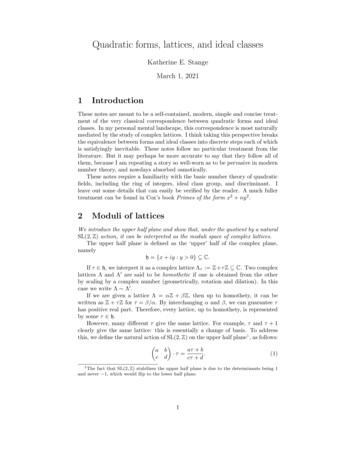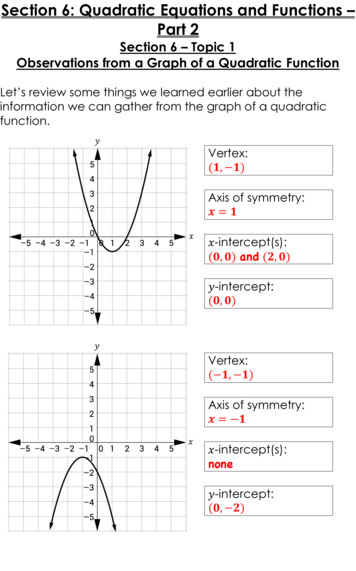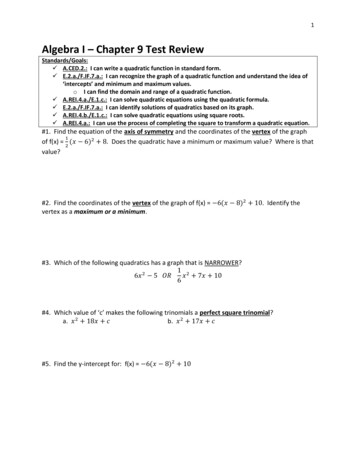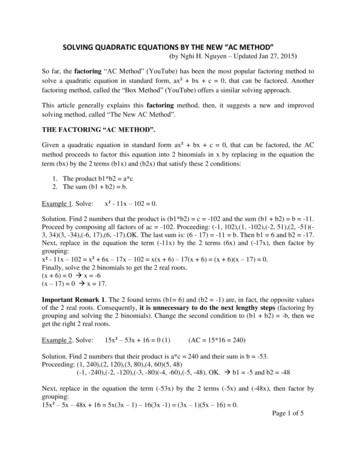
Transcription
Quadratic forms, lattices, and ideal classesKatherine E. StangeMarch 1, 20211IntroductionThese notes are meant to be a self-contained, modern, simple and concise treatment of the very classical correspondence between quadratic forms and idealclasses. In my personal mental landscape, this correspondence is most naturallymediated by the study of complex lattices. I think taking this perspective breaksthe equivalence between forms and ideal classes into discrete steps each of whichis satisfyingly inevitable. These notes follow no particular treatment from theliterature. But it may perhaps be more accurate to say that they follow all ofthem, because I am repeating a story so well-worn as to be pervasive in modernnumber theory, and nowdays absorbed osmotically.These notes require a familiarity with the basic number theory of quadraticfields, including the ring of integers, ideal class group, and discriminant. Ileave out some details that can easily be verified by the reader. A much fullertreatment can be found in Cox’s book Primes of the form x2 ny 2 .2Moduli of latticesWe introduce the upper half plane and show that, under the quotient by a naturalSL(2, Z) action, it can be interpreted as the moduli space of complex lattices.The upper half plane is defined as the ‘upper’ half of the complex plane,namelyh {x iy : y 0} C.If τ h, we interpret it as a complex lattice Λτ : Z τ Z C. Two complexlattices Λ and Λ0 are said to be homothetic if one is obtained from the otherby scaling by a complex number (geometrically, rotation and dilation). In thiscase we write Λ Λ0 .If we are given a lattice Λ αZ βZ, then up to homothety, it can bewritten as Z τ Z for τ β/α. By interchanging α and β, we can guarantee τhas positive real part. Therefore, every lattice, up to homothety, is representedby some τ h.However, many different τ give the same lattice. For example, τ and τ 1clearly give the same lattice: this is essentially a change of basis. To addressthis, we define the natural action of SL(2, Z) on the upper half plane1 , as follows: aτ ba b.(1)·τ c dcτ d1 The fact that SL(2, Z) stabilizes the upper half plane is due to the determinants being 1and never 1, which would flip to the lower half plane.1
Geometrically, this is the action of Möbius transformation2 . Some importantMöbius transformations include translation by 1 and inversion in the unit circle: 1 1T , τ 7 τ 1,0 1 0 1S , τ 7 1/τ.1 0Proposition 1. Λτ Λτ 0 if and only if τ 0 M · τ for some M SL(2, Z).Proof. The key to the proof is that M implements a change of basis on thelattice, which alters τ but does not change the lattice. To see this explicitly,witness thatΛM ·τ Z aτ bZ (cτ d)Z (aτ b)Z Z τ Z.cτ d(2)Conversely, if τ and τ 0 give the same lattice, then Z τ Z Z τ 0 Z, whichinduces the relationship thatατ 0 a bτα c dτ,for some α C. This is exactly the relationship (1).We have now shown that the upper half plane, under the quotient by the action of SL(2, Z), is the moduli space of lattices up tohomothety.A fundamental domain is given byF : {z h : 1/2 Re(z) 0, z 1} {z h : 0 Re(z) 1/2, z 1}.The fact that this is a fundamental domain, i.e. every SL(2, Z)-orbit containsexactly one element of this set, is elementary, but somewhat lengthy. It appears in many books. Among those in frequent rotation for me, is Chapter35 of Voight’s Quaternion Algebras; another is the first chapter of Silverman’sAdvanced Topics in the Arithmetic of Elliptic Curves; there are many others.Note that the matrix I acts trivially, so it is sometimes useful to thinkabout the action of PSL(2, Z) : SL(2, Z)/ I, which is faithful. One thingworth saying about the full story is that PSL(2, Z) is generated by the matricesS and T defined above. It is worth looking at the image of the fundamentaldomain and its images under small words in S and T in either of the referencesmentioned above.2 I recommend viewing the Möbius Transformations Revealed as an introduction to thistopic more generally2
3Ideal Classes as K-LatticesWe show that ideal classes of imaginary quadratic fields can naturally be interpreted as complex lattices up to homothety.I assume basic familiarity with ideal classes in the rings of integers of numberfields. For the remainder of these notes, K is an imaginary quadratic field.The embeddings of K into C can be obtained by extending scalars: C R Q K. The metric topology induced by C on K agrees with that of K as aQ-vector space. The salient point is that lattices of K are still lattices in C.This doesn’t work for real quadratic fields or higher degree fields. We just getlucky here.Recall that fractional ideals are, in particular, lattices in K. Therefore wemay think of them as complex lattices generated by elements of K. Taking intoaccount homothety, we arrive at the following definition.Definition 1. A complex lattice Λ αZ βZ is called a K-lattice if β/α K.This property is insensitive to the choice of basis of the lattice, since ifα0 aα bβ, β 0 cα dβ, then α/β K if and only if α0 /β 0 K (i.e.the SL(2, Z) action on h takes K to K). Furthermore, being a K-lattice isan invariant under homothety. It is always possible to scale so that α, β Kindividually (e.g., take 1 and β/α as basis).Finally, any K-lattice can be scaled to lie as a sublattice of OK . To see this,write Λ αZ βZ, for α, β K. The ideal (α, β) is a fractional ideal, and sothere is some d OK such that d(α, β) OK . Then3 dΛ OK .Hence, the K-lattices are exactly those which arise from τ K, under thetheory of the upper half plane.Next we wish to discuss the endomorphisms of a lattice; the collection ofsuch is called the order.Definition 2. The order of a K-lattice isord(Λ) {x C : xΛ Λ}.The order of a lattice is clearly invariant under homothety. It is also insensitive to any choice of basis for the lattice, hence ord(Λτ ) ord(ΛM ·τ ) forM SL(2, Z), i.e. it is invariant under the SL(2, Z) action. So an element τ hcan be said to have an order.Proposition 2. The order ord(Λ) is a subring of OK with unity.Proof. First, ord(Λ) K, since, applying x ord(Λτ ) to the first basis element1, we have x Λτ Q(τ ) K. The only difficult aspect is that ord(Λ) OK . By homothety, we may assume Λ OK . Therefore if x ord(Λ), thenxn Λ Λ OK for all positive integers n. Choosing λ Λ, we have λxn OKfor all n, which means that OK [x] is a fractional ideal, hence finitely generated,3 Warning: Λ need not equal (α, β) (one is a Z-span of a basis, and the other an O -span,Khence there is a one-way inclusion).3
implying x is integral. Hence ord(Λ) OK . Finally, that it is a subring withunity is clear.We will focus this exposition on the case of lattices with order OK , but thereis a rich theory when one includes other orders.Proposition 3. Fix an embedding of K into C. Under the embedding, everyfractional ideal of OK is a K-lattice with order OK . Furthermore, any K-latticecan be scaled to lie in K, and it has ord(Λ) OK if and only if any such scalingis a fractional ideal of OK . Two K-lattices with order OK are homothetic if andonly if the corresponding fractional ideals are equivalent.Proof. A fractional ideal I is naturally a K-lattice, and it has order OK by thedefinition of an ideal. Conversely, consider a K-lattice Λ with ord(Λ) OK .It is an OK -module, and finitely generated, hence a fractional ideal if scaled tolie in K. The ideals I1 and I2 are equivalent if and only if I1 dI2 for somed K; this is exactly homothety.The following restatement is an immediate corollary.Corollary 1. Ideal classes of OK are in bijection with K-lattices of order OK ,up to homothety. The identification is obtained by considering an ideal class asa complex lattice under a fixed embedding of K in C.We use the notation Cl(K) for the ideal class group of OK .Finally, we record a useful lemma for later.Lemma 1. Suppose τ is a complex root of a polynomial ax2 bx c Z[x]where gcd(a, b, c) 1. Then ord(Λτ ) Z[aτ ].Proof. We verify that aτ Λτ τ Z τ 2 Z Z τ Z because τ satisfies aτ 2 bτ c. This shows Z[aτ ] ord(Λτ ). Conversely, suppose α e f τ fore, f Q. Then the endomorphism multiplication-by-α has matrix (in basis 1and τ ), e cf /a.f e bf /aThe condidition that αΛτ Λτ is exactly the condition that the entries beintegral. As gcd(a, b, c) 1, we find that a f . So ord(Λτ ) Z[aτ ].4Quadratic forms as K-LatticesIn this section, we interpret primitive integral binary quadratic forms of fundamental discriminant up to proper equivalence as Q( )-lattices up to homothety.Definition 3. An integral binary quadratic form is an expression ax2 bxy cy 2in Z[x, y]. The discriminant of the form is b2 4ac. If 0, the form isdefinite. It is called primitive if gcd(a, b, c) 1.4
It is a fact of the theory of quadratic forms that definite forms take onlyvalues of a single sign. This is a consequence of the fact that, over R, anybinary quadratic form can be diagonalized4 ; the discriminant is negative if andonly if the diagonalization is x2 y 2 or x2 y 2 . If the former, we call it positivedefinite (otherwise, predictably, negative definite).One of the fundamental questions number theory seeks to answer is: Whatare the values taken by (represented by) a quadratic form? It is natural toconsider quadratic forms up to change of variables, which shouldn’t change theset of values a form represents. To this end, we define an action of SL(2, Z).Definition 4. Let M SL(2, Z). Then, M acts on vectors in Z2 . Writing v (x, y) for the vector of indeterminates, considered a column vector, a quadraticform f (x, y) can be given an action by M :M · f (v) f (M · v).Two integral binary definite quadratic forms f (x, y) and g(x, y) are properlyequivalent if they are in the same orbit. In that case we write f g.Explicitly, this is ac b· f (x, y) f (ax by, cx dy).dThe action of SL(2, Z) doesn’t change the discriminant of the form (this is simplya computation). Therefore we may define the form class group Cl( ) to be theset of proper equivalence classes of primitive integral binary quadratic forms ofdiscriminant .Quadratic forms also give rise to complex lattices, although the associationis slightly less obvious. A quadratic form f (x, y) ax2 bxy cy 2 has anassociated polynomial ax2 bx c (by setting y 1). If 0, it has anassociated pair of non-real complex conjugate roots τf , τf , namely b .(3)2aLet us assign these in such a way that τf h. Note that the minimal polynomialof τf has discriminant , which implies Z[τf ] has discriminant .Proposition 4. Let be a negative integer5 . There is an SL(2, Z)-equivariantbijection between primitive integral binary quadratic forms f of discriminant and quadratic irrationalities τf of discriminant . The equivariance is given byτM ·f M 1 (τf ).Proof. We have seen how to associate to f an element τf in the upper half planewhich is a root of f (x, 1). To invert this, one takes the minimal polynomial of4 Here5 IfI mean the Gram matrix. 2, 3 (mod 4), this bijection is vacuous.5
τf (which is quadratic) and homogenizes to reintroduce the variable y. There’sa small hitch here: any scaling of the quadratic form (i.e. λf in place of f ) willproduce the same τf . So one must choose the primitive form amongst the scalarmultiples.We must also show that the action of SL(2, Z) on integral binary positivedefinite quadratic forms f is equivariant with the inverse action of SL(2, Z) onthe root τf , explicitly, τM ·f M 1 (τf ). This is a computation, so we omit theproof, but, for example, τa(x 1)2 b(x 1) c τax2 bx c 1.Before we state the corollary giving a bijection between forms and lattices,we pause because we prefer to restrict our attention to K-lattices of the maximalorder OK . The following definition will be useful for characterizing discriminants associated to the maximal order.Definition 5. A discriminant is fundamental if it is of the form 4mfor m 2 or 3 (mod 4) and squarefree, of the form m for m 1 (mod 4)squarefree.It is a fact that these correspond (except for 1) bijectively to quadraticnumber fields, as the discriminants of their rings of integers. (Non-fundamentalnon-square discriminants give other orders6 , i.e. full-rank subrings of OK withunity.)Now we can state the corollary.Corollary 2. Let be a negative fundamental discriminant associated to quadraticimaginary field K. There is a bijection between proper equivalence classes ofintegral binary quadratic forms of discriminant and homothety classes of Klattices of order OK .Proof. From Proposition 4, there’s a bijection between such forms and τf beingquadratic of discriminant in the upper half plane, taken modulo SL(2, Z).Once we have associated τf to f , one also has an associated K-latticeΛf : Λτf .This lattice has order Z[aτf ] (by Lemma 1), which has discriminant7 . Therefore, since is fundamental, it is a K-lattice of order OK .Conversely, any K-lattice Λ of order OK is, up to homothety, of the formΛ Z τ Z where τ K. Therefore τ is quadratic, and we have just seen thatthe discriminant of τ matches the discriminant of its order. If Λ Λτf thenτf τ and so this is a bijection.6 Theseare also all the orders obtained from lattices as in Definition 2.general, the discriminant of a power basis is the discriminant of the minimal polynomial.Hence the discriminants of a general polynomial f of degree n and of the power basis of itsroot τ are related by disc(f ) an disc(1, α, . . . , αn 1 ).7 In6
5Quadratic forms and ideal classesWe now state the full bijection. We let K be an imaginary quadratic field withdiscriminant K .Theorem 1. We have bijectionsCl(K) {K-lattices of order OK }/ Cl( K )given by (left to right),a 7 Λa αZ βZ 7 N (αx βy)/N (a).(4)and by (right to left), b 22Z 7 ax bxy cy 7 Λf Z 2a ! b a,2(5)Proof. The bijection is given by Corollaries 1 and 2, wherein we find the explicitmaps. Tracing through these, it is easy to see the explicit map in the right-to-leftdirection, namely (5).For the inverse, we pass from a K-lattice Λa αZ βZ representing anintegral ideal a, to the corresponding quadratic form, which should arise from theminimal polynomial for β/α. One slick way to obtain this minimal polynomialis to recover it as the characteristic polynomial of endomorphism x 7 (β/α)xon K, i.e. det(Ix mβ m 1α ) N (αx βy)/N (α).Thus the inverse map should bea 7 Λa αZ βZ 7 κN (αx βy),(6)where κ needs to be specified.To set κ and verify that we obtain an inverse, we use a nice choice of latticehomothety. Assume β/α satisfies the polynomial ax2 bx c Z[x] withgcd(a, b, c) 1. Then, b αZ βZ aZ Z.2The rightmost coefficient, call it γ, is an algebraic integer generating OK (it2has minimal polynomial x2 bx b of discriminant ), and this lattice has4covolume a inside OK Z γZ.We compute !! 1 ! b b y Na,N ax 22 b2 2 1 a2 x2 abxy y a4 ax2 bxy cy 2 .7
Hence, the correct scaling is more canonically given asN (αx βy),N (a)which is clearly invariant under homothety.Thus the inverse to (5) is therefore (4).6Finiteness of the class groupWe now briefly indicate a few payoffs. Given a quadratic form f , we can applythe action of SL(2, Z) to place τf in the fundamental domain. This gives a reduction theory, i.e. an algorithm that replaces f with a canonical representativeof its equivalence class. Working this out explicitly, we obtainProposition 5. Let f (x, y) ax2 bxy cy 2 . Then τf F if and only if b a c with b 0 whenever b a or a c.Such a form is called reduced. In particular, this implies that for fixed discriminant b2 4ac, there are only finitely many reduced forms (to see this,note that 3a2 and so there are finitely many choices for a and b; but anysuch choice determines at most one c).We write Cl( ) for the set of equivalence classes of quadratic forms of discriminant . We have just shown that Cl( ) . Via the bijection, thisimmediately implies Cl(K) .7Composition of Quadratic FormsSince the class group comes with a group operation, so must the set of equivalence classes of quadratic forms, inherited through this bijection. The composition of quadratic forms was actually observed long ago, before class groups. Anexample of this sort of thing is the identity(a2 b2 )(c2 d2 ) (ac bd)2 (ad bc)2 ,which is essentially the multiplicativity of the Gaussian norm, but which we cannow interpret as the identity (1)(1) (1) in the class group of Z[i]. A generalcomposition law that lines up with this story can be found in Cox’s book Primesof the form x2 ny 2 . Or you can derive it yourself from the bijection above.8
Proof. A fractional ideal Iis naturally a K-lattice, and it has order O K by the de nition of an ideal. Conversely, consider a K-lattice with ord() O K. It is an O K-module, and nitely generated, hence a fractional ideal if scaled to lie in K. The ideals I 1 and I 2 are equivalent if and only if I 1 dI 2 for some d2K; this is exactly homothety.










